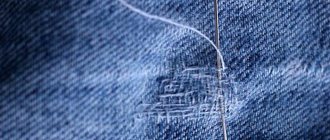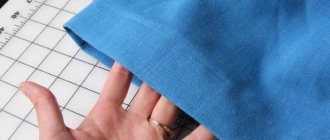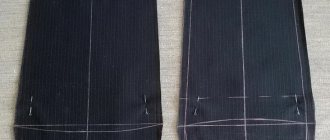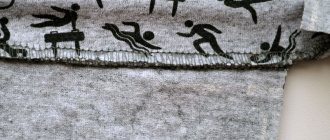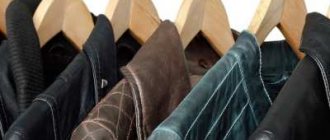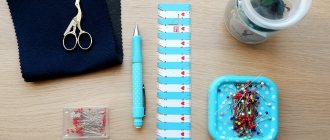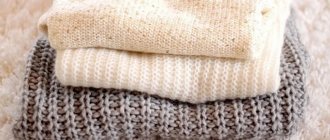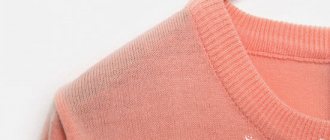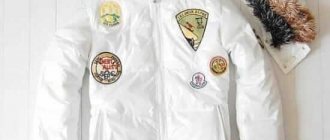Let's imagine this situation: You came to the store and saw the trousers of your dreams, you are taking them to the fitting room, but something went wrong... You put them on and realize that they do not fit exactly the way you want. Everything seems to be fine, but the reflection in the mirror doesn’t excite you. The size is yours, it fits well on the hips, the model fully matches your body type, but the length is clearly not suitable for your height. What to do? Will you really refuse this purchase?
Maybe we can change their length? We will provide you with detailed instructions on how to do this, and you will enjoy your new trousers for a very long time.
We hem trousers on a machine with our own hands
To correctly determine the required length of trousers, you must try them on.
This is done with shoes and a belt. This way the measurement will be more accurate. Depending on the style and model, the following rules apply:
- the length of classic trousers should reach the middle of the heel;
- skinny trousers are shorter than wide ones;
- summer models with cuffs or a collar are worn with a gap between the edge of the shoe and the trouser leg;
- baggy pants can go all the way down to the soles, but should not touch the ground;
- Jeans should be of such length that the lacing on the shoes is hidden, while the trouser leg curls slightly at the ankle.
Fold the excess outwards, mark the fold with chalk or soap and pin it with pins. If the figure is asymmetrical, each pant leg is marked.
Before work, the trousers are laid out on a flat surface. The legs are connected seam to seam, the waist line should match. To prevent the fabric from moving, you can pin it together with safety pins.
Further actions depend on the material and model of the pants.
How to hem classic and school trousers
As a rule, classic men's and school trousers are hemmed using a special braid.
Important! Tape made from natural fabrics is pre-steamed or doused with boiling water. This is necessary so that during the first wash it does not shrink, pulling the fabric of the trouser leg.
To hem school trousers, in addition to the machine, you will need:
- scissors;
- ruler (preferably a corner);
- chalk or soap (its traces are easier to remove from the surface);
- needle and thread;
- trouser tape (braid);
- safety pins.
Draw a straight line on a flat surface using a ruler and soap. This is the future fold line. Step back from the line by at least 3–4 cm. If the child is growing quickly, the offset can be made larger (up to 10 cm). This will make it possible to undo the seam in the future and lengthen the legs.
Draw another line along the marks. It marks the location of the cut. If the scissors are sharp, it is better to cut off the excess on both legs at once.
After the excess fabric is cut off, the edge must be ironed. Wrap the trouser leg along the fold line and, holding it, warm it with a hot iron through the fabric from the inside of the trouser legs. It is not recommended to use the iron in this case: you can move the fabric and get an uneven fold line.
The ironed edges are processed using an overlocker or a regular machine (zigzag stitch).
Next step: sew on the trouser tape. It is applied close to the fold line. To reduce wear on the trouser fabric, the tape may protrude slightly (up to 1 mm). It is stitched with a machine as close as possible to the edge of the braid, retreating about 2 mm from the fold. For convenience, the tape can be pre-baited. The second line is sewn along the opposite edge of the tape.
Important! The cut of the braid must be bent or singed (if it is synthetic), otherwise it will gradually unravel.
After the trouser tape is sewn, roll up the trousers so that it protrudes slightly. Iron the edge again.
The trouser leg is hemmed from the wrong side using a hidden (invisible) stitch.
Hem trousers with a hidden seam (invisible seam) description
Blindstitching can be done in two ways: by machine and by hand. Let's look at the first option.
A blind stitch is a type of zigzag stitch; most modern machines have this feature. It will require a special foot. Usually it comes included, but, in extreme cases, it can be purchased separately in the store.
In accordance with the instructions for the sewing machine, set the necessary settings. In simple models, it is enough to select the type of seam; in machines, it is more difficult to additionally adjust the length of the stitches and the width of the line.
Attention! The trousers are sewn only from the wrong side.
To prevent the fabric from moving during the sewing process, it is better to bait it first.
Fold the edge again (away from you), leaving about 5 mm for the future seam.
The fabric is positioned so that the fold is exactly under the machine foot guide. In this case, the peaks of the stitch will capture the fold only with their apex, and the entire main seam will run along the wrong side of the product.
So that the seam is really not visible from the front side:
- the threads should be matched as closely as possible to the tone of the product;
- Adjusting the seam height and width also affects its visibility (if these settings are available).
When hemming trousers with a blind stitch, it is important not to rush. Uneven stitching looks sloppy and will be noticeable.
Housewife tricks
- To accurately determine the length, the model must be completely still. This is impossible if you are the model yourself. Turning to help from family members or friends is inevitable.
- If it is impossible to attract outside observers or if the model is not physically nearby, take the most successfully hemmed trousers and shorten the new ones, focusing on the length of the old ones.
- Gossamer is not as reliable as hemming by hand, although it gives a smooth, beautiful edge to the product . Many people glue the tape, and for reliability they also hem the bottom.
- If the store doesn’t have the ribbon of the right color, take another one - it’s not a problem for tight trousers, any color will suit them. It won't be on the surface. But thin summer ones, especially light ones, will require more attention. They require a white web, but it is found in stores more often than other colors.
- There is only a narrow adhesive tape available - no problem, take twice as much of it and glue it in two rows, placing them next to each other.
- The length of the trousers can be easily determined with an iron. To do this, determine the length on the model by bending the trouser leg up inside out and securing it at the back with one pin. We take off the pants and lay them out on the ironing board. By matching the side seams, we reach the even desired length line along the entire circumference. We smooth it with an iron and remove the pin. That's it, the line is drawn. Next, we cut off the excess, turn the trousers inside out and glue the tape.
How to hem knitted trousers on a sewing machine
Hemming knitted trousers is much more difficult. Mainly due to the nature of the fabric . Knitwear is a very elastic material, so the seam should also stretch well. A regular stitch made with a shuttle machine is not suitable for it.
Professionals use a special machine (flat stitch or cover stitch) and a knitted overlock for this material. The peculiarity of the seam made on the cover stitch is that from the inside it looks like a pigtail. This stitch does not deform the fabric when sewing and does not tear when the product is stretched.
However, even with a household sewing machine you can hem knitted trousers beautifully and accurately. It is enough to know the following secrets from professionals:
- A regular universal knitting needle is not suitable. There are two options: purchase a special one marked “jersey” or choose the thinnest one possible.
Reference! The second method is still chosen by “Soviet-trained” masters. With certain skills, a seam made on knitwear with a thin needle is not inferior to one made with a “jersey” needle.
A needle for knitwear, at first glance, is no different from a regular one, however, if you look closely, you will notice that its point is rounded. This needle tip does not tear the knitted fibers, but gently pushes them apart and passes between them. Another option for marking such needles is ball point.
Thread Requirements:
- For knitwear, you need to choose the thread very carefully. Only high-quality, very thin threads are suitable, elastic, but at the same time durable. The ideal option is on large cone-shaped reels. These are professional and, as a rule, far from cheap threads.
- It is important to correctly set the thread tension on your machine. With due patience, you can do this yourself, or you can call a specialist (if the machine is old, then it is better to entrust it to a professional right away).
Tape is not used for hemming knitted trousers. Enough to tuck the cut edge.
If the trousers are made of thick knitwear, the edge is processed and folded only once. Thinner material can be folded twice to hide the cut.
For knitwear, two types of stitches are used on a regular machine: interrupted and regular zigzag. The latter is adjusted so that the stitch width is less than the length of the stitches. The end result should be a seam with minimal breakage. This stitching will allow the trousers to stretch well without tearing.
A broken zigzag can also be used to finish the edge.
Hemming trousers using a web
The web is very convenient to use for hemming the bottom of the product. It’s just not advisable to glue the hem of a skirt made of thin and “delicate” fabric. The cobweb will definitely be “stamped”, and the bottom of the skirt will become stiff. It is better to hem the skirt by hand, with a very thin thread and needle. In other cases, it is better to use the adhesive web in combination. That is, first fix the hem of the trousers with a web. After this, you can also hem them manually, since adhesive materials lose their properties due to frequent washing and over time, the glued area will come loose and you will have to hem the trousers by hand.
Some tips
- To ensure that the knitwear stretches evenly during the process, you can stitch it through paper. Both regular tape, cut into strips, and masking tape are suitable for this. This technique will also help if the stitching does not turn out straight. It is enough to draw a straight line on paper and stitch exactly along it. After stitching, the paper is carefully removed.
- If the pants have decorative inserts, then it is more convenient to shorten along these seams.
- Sweatpants with an elasticated ankle can also be shortened. To do this, you need to rip off the elastic, cut off the excess length of the trouser leg and connect the parts using an overlocker.
- The stitching starts from any side seam. This way it will be much smoother and neater.
If you have a machine at home and minimal skills in working with it, you can hem any trousers. So excessive length is not a reason to refuse something you like.
What to wear with a black vest?
Fashionable women's windbreakers 2021 photo
Invisible seam No. 4 – for knitwear and knitted items
No one is safe from a hole in their sweater. Many people know that such holes tend to spread quickly. To prevent this from happening, you should repair the product correctly. Knitwear and knitted items have their own invisible seam.
Let's pay attention to the diagram:
Progress:
- First you need to find the threads that have broken and bring them to the wrong side.
- Next, we arm ourselves with thread to match the color of the product. We insert it into the needle.
- We tie the end of the thread to the end of the broken thread.
- We bring the needle to the front side. We pass through the 2 upper loops, then through the 2 lower ones (see diagram).
- Continue darning until all the loops are secured.
- Let's go to the wrong side. We tie the thread to the second torn end.
- Ready!
We recommend: How to disassemble a toilet cistern with a button
If the knitting is small, you can use a magnifying glass.
A clear example of how to properly sew up a hole on knitted items and knitwear:
Final processing
After processing the bottom of the trousers, they must be washed and ironed. Before doing this, you should fasten the zipper and all buttons. It is better to choose a detergent for delicate items.
When washing by hand, you can use a brush as an auxiliary tool. You need to apply soap (powder) to it and thoroughly wipe the entire surface of the product, paying special attention to the bottom that has just been hemmed. It is strictly prohibited to wring out the item. When drying, the water should drain on its own.
After shortening the trousers, it is recommended to start ironing from the pockets. Next, the surface of the iron goes along the entire perimeter of the belt. All folds are neatly straightened. To form the arrows, you need to combine the outer seam of the trouser leg with the inner one. The iron should be moved smoothly to avoid wrinkles and unevenness. At the moment of passing the fold line, you should turn on the “pair” function.
Sometimes the arrows disappear quickly. To make them last a long time, you can use an old proven remedy. Before ironing the product, rub the fabric with any piece of soap.
Light-colored pants may have unsightly iron marks. To avoid this, it is recommended to iron clothes through gauze folded in several layers.
It is not difficult to shorten trousers at home, so there is no need to go to a clothing repair shop. The main thing is to have the necessary tools and know in advance the desired length of the product. If a person has basic sewing skills, the work will take no more than half an hour. Making your own binders looks great and can save you time and money.
Apply soap to the surface of the product with a brush
It is prohibited to wring out the product
When drying, the water should drain on its own.
Start ironing from pockets
To form arrows, combine the outer seam of the trouser leg with the inner one.

